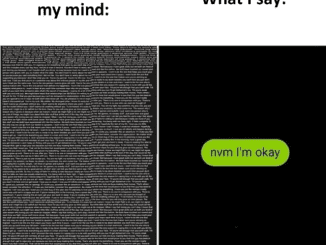Have you ever stared at an image so long that it seemed to blink back at you? That’s exactly the kind of brain-bending magic happening in this viral optical illusion. At first glance, it’s a strange black-and-white sketch with scattered shadows and vague facial hints. But if you follow the instructions—stare at the four dots in the center for 30 seconds, then blink while looking at a light-colored ceiling—you’re in for an unforgettable surprise.
This illusion taps into something deeper than eyesight—it reaches right into your brain’s pattern recognition system and shows just how powerful visual memory really is.
How This Trick Works: It’s Not Just Black and White

You may be wondering, how is it possible that staring at a few dots can lead to a full, vivid face appearing in mid-air? Welcome to the world of afterimages. This phenomenon occurs when your eye’s photoreceptor cells (the ones that detect light) become overstimulated and temporarily desensitized. Your brain fills in the gaps based on contrast and familiar shapes.
So when you look away and blink, your brain recreates what it saw in reverse—like developing a photo in your mind’s darkroom. But the wild part? What you see isn’t just a random face—it’s eerily familiar to millions of people.
Wait… Was That a Face You Recognized?
Yep. Most people who try this trick report seeing the face of Jesus. The image you’re looking at is a negative-style illusion that subtly outlines facial features in shadow, using strategic placement of high-contrast areas to mimic his commonly depicted likeness.
You’re not hallucinating—you’re just witnessing the power of your brain connecting dots (literally) and recreating a familiar figure based on cultural imagery you’ve likely seen many times before.
Why You Can’t Unsee It Once You Do
Here’s the fascinating part: once you see the face, it becomes almost impossible to “unsee” it. That’s because your brain has now stored the pattern. This is known as priming—once you’ve been exposed to a specific interpretation of an image, your mind will automatically seek it again.
Video : Optical Illusion Picture Collection With Instructions
It’s similar to when you hear a song lyric incorrectly once, and then your brain keeps inserting the wrong words every time you hear it. Once that mental groove is carved, it sticks.
Common Reactions and Missteps
Some people get frustrated with this illusion because they blink too fast, don’t stare long enough, or aren’t in a well-lit space. Others might not see anything at all and assume the trick doesn’t work.
Here are some tips for the best results:
- Stare directly at the four dots in the center without moving your eyes
- Do this for at least 30 seconds (set a timer if needed)
- Then immediately shift your gaze to a plain, light-colored wall or ceiling
- Blink repeatedly and allow your eyes to adjust
Psychology Behind the Illusion
This image doesn’t just play tricks—it tells a story about how our brains process visual information. Human beings are hardwired to recognize faces, especially familiar ones. It’s part of pareidolia, the tendency to perceive meaningful images in abstract patterns (like seeing shapes in clouds or faces in rocks).
In this case, the illusion leverages your familiarity with religious or cultural iconography, using simple shapes and contrasts to activate deeply ingrained visual memory pathways.
Why These Illusions Go Viral
Let’s be honest—illusions like this one are fun. But they’re also deeply shareable because they’re a form of low-stakes mystery. You want to solve the puzzle. You want to compare your experience with friends. And when the answer is unexpectedly powerful—like the sudden appearance of a holy figure—it hits that emotional and social sweet spot that makes you want to click, comment, and share.
Video : Can you find the hidden face? 🤯
Test It with Friends (and Watch the Shock)
Want to really enjoy this image? Show it to someone else without telling them what it’s supposed to be. Just say, “Stare at the dots for 30 seconds, then look at the ceiling and blink.”
Watch their expression shift from confusion to awe. It’s like a magic trick that doesn’t require sleight of hand—just a little patience and the perfect blend of light and shadow.
Conclusion: What You Saw Was More Than an Illusion
At the end of the day, this isn’t just a clever picture. It’s a reminder that our brains are constantly filling in the blanks—seeing patterns, making assumptions, and pulling from memory. It’s both science and art. And the next time someone says, “Seeing is believing,” you’ll know just how complicated that idea really is.
So, what did you see? Share your experience, challenge a friend, and remember—sometimes, the most powerful images are the ones that aren’t really there… until your brain decides they are.


